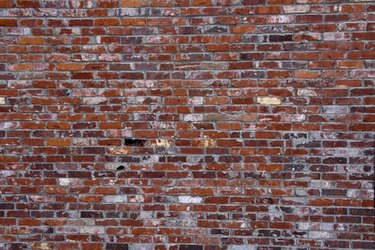Things You'll Need
Tape measure
Level
Chalk line
1 inch by 3 inch furring strips
Circular saw
Drill
Assorted bits
Concrete screws
Corrosion-resistant nails
Tin snips
Utility knife
Snap lock tool

Over time the brickwork on your house may start to look worn and faded. Installing vinyl siding over existing brick is an easy and economical way to update the look and feel of your house. Vinyl siding is composed of a series of channels and panels that interlock with one another to form a cohesive, weather-resistant shell over the exterior of your house. Furring strips should be mounted to the brick, and then the vinyl channels are affixed to the wooden furring strips. The siding panels are fitted into the channels and fastened to the furring strips.
Affixing Furring Strips to Brick Siding
Step 1
Snap base guide lines around the bottom of the house. Consult the vinyl siding manufacturer's instructions regarding the distance from the ground that the vinyl siding should begin.
Video of the Day
Step 2
Affix furring strips horizontally around the base of the house. Follow your chalk guide lines. Fasten the furring strips by using a drill affixed with a masonry bit. Drill through the furring strips and into the bricks behind them; use concrete screws to hold the furring strips in place. Cut furring strips to the appropriate length using a circular saw.
Step 3
Attach furring strips vertically along the sides of the house. Position the furring strips 18 to 24 inches apart.
Step 4
Install furring strips along the eaves of the house.
Installing Vinyl Siding
Step 1
Attach the starter strip along the base of the house. Use corrosion-resistant nails to fasten the aluminum starter strips to the furring strips. Take care not to over-drive the nails and warp the starter strip.
Step 2
Install J-channel to the corners of the house, and around windows and doors. Use tin snips to cut the vinyl J-channel pieces to length. Leave 1/4 inch of space between vinyl pieces to allow for expansion in hot weather. Fasten the J-channel with corrosion resistant nails positioned in the center of the prefabricated nail slots. Leave between 1/32 and 1/16 inch of the nail shaft exposed to allow the vinyl to move in high heat.
Step 3
Install utility trim to the underside of windows and along horizontal eaves. Attach J-channel to sloped eaves.
Step 4
Install the vinyl siding panels starting from the base and work up. Fit the first row of panels into the starter strip, and position the ends in the J-channel, leaving 1/4 inch of space between the end of the panel and the back of the channel. Where two panels meet, overlap them by 4 inches. Use corrosion resistant nails to attach the vinyl siding panels to the wooden furring strips.
Step 5
Check the level every 3 or 4 siding courses. If you find that the level is getting off track, make minor adjustments over several courses, as opposed to making a single, dramatic repair.
Step 6
Cut the panels to fit around windows and doors. Use tin snips to cut the width of the panels, and a utility knife to slice them lengthwise.
Step 7
Punch lugs in the edge of panels fitting underneath windows and into utility trim run along horizontal eaves. Use the snap lock tool to punch lugs every 16 inches. Lock the panels into place by punching the edge with punched lugs up into the utility trim.
Step 8
Cut panels to fit into J-channel run along sloped eaves. Use tin snips and your utility knife to cut the panels to the write length and angles.
Video of the Day